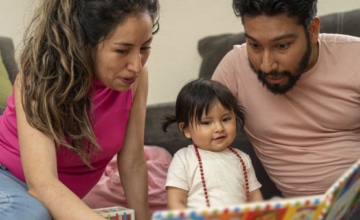Why Are Questions Important for Learning?
When your child asks a question, she is taking an active role in her own learning. She is trying to figure out how her world works by seeking information. As she asks questions, she is developing critical thinking skills that build brain power.
Asking questions is also an important form of communication. Your child is seeking out a knowledgeable person—you, another child, a family member or caregiver—and requesting information that he needs or wants.
Finally, when your child asks questions, it shows how important strong relationships are in helping children learn and grow. Children turn to the people they love and trust to help them learn.
Can Babies and Toddlers Ask Questions Before They Can Use Words?
As children get older—usually starting at about 2 ½ to three years—they will use language to ask questions. But there are many other ways to ask questions that don’t require words.
A baby or toddler may be asking a question when she:
- Looks closely at an interesting object or person
- Reaches for an object or person
- Points to something
- Touches something
- Looks at you with a questioning facial expression
Aaliyah, age 10 months, is sitting on the grass with her mother. She sees a squirrel run by and stop for a moment at the base of a nearby tree. Aaliyah stares at the squirrel for a few seconds and then looks at her mother. She waves her arm and hand toward the squirrel, as if she is reaching for it. Her mother says, “Are you wondering what that animal is? It’s a squirrel. Squirrels live in trees.” Aaliyah bounces up and down as she watches the squirrel run across the grass and race up the tree.
When a young child asks a question without using words, first say the question or questions you think she might be asking out loud: “Are you trying to tell me you don’t like the sound of the fire engine and you want me to pick you up?” Adults have to imagine being the child for a moment and wonder what questions they may have. When you say those questions out loud, you help your child develop language skills.
What Questions Do Children Ask From Birth to Three?
The types of questions that children ask (using words) will change as they develop. Below you will find a timeline for the ages at which you can typically expect children to ask the what, where, when, who, and why questions. Note that young children’s verbal skills develop at different rates. Any consistent sound a child uses for an object or person (like “baba” for bottle) is considered a “word”.
| Age Range | Questions Asked |
|---|---|
| 21-24 months | “What’s that?” (Or simply, “Dat?”) |
| 25-28 months | Questions are asked with rising intonation |
| 26-32 months | Asks where questions |
| 36-40 months | Asks who questions |
| 37-42 months | Asks “Is…?” and “Do…?” questions |
| 42-49 months | Asks when, why, and how questions |
[Note: This table was developed using information from pages 269-272 of: Linder, T. (2008). Transdisciplinary play-based assessment, 2nd edition. Baltimore, MD: Paul H. Brookes Publishing.]
What Should I Do When My Baby or Toddler Asks a Question?
Of course it’s important to respond to a child’s question; but avoid the temptation to jump right in and answer it. Why? Because your child then misses out on the chance to use his own thinking skills to figure the answer out himself, with your support.
Here are some examples of how you might respond to your child’s questions that encourage her to get her wheels turning:
Offer an opportunity or experience in response to the question.
Nico, age 6 months, is looking at the bright orange dish towel sitting on the counter. He looks at his mother and then back to the towel. His mother says, “Do you want the dish towel? Would you like to touch it?” She hands Nico the dish towel and he takes it with both hands, brings it up to his face, and rubs it on his cheek. His mother says, “How does it feel? Is it soft or a little rough?”
Nico’s mother offered him the opportunity to explore and learn about the object he was “asking” about.
Suggest a new way to explore in response to the question.
Carla, aged 18 months, was trying to figure out how to open the drawer of the toy cash register. She was pushing on the drawer and shaking the cash register. She turned to her child care provider and said, “Hep.” Her child care provider responded by saying, “Are you asking for help opening the drawer?” She then pointed to a button on the cash register and said, “Can you push the big red button? See what that does.”
Providing guidance to Carla gives her the chance to discover the answer to her own question.
Ask a question in response—for children aged 30 months and older.
Alan, aged 36 months, was fascinated with a large machine at the building supply store. He asked his mother, “What dis?” She replied, “That’s a forklift. What is it doing?” Alan watched for a while and then said, “Boxes go up!”
Asking Alan a question encouraged him to take an active role in his own learning.
What Can I Do to Create an Environment That “Invites” Questions?
The following ideas highlight a number of ways you can nurture your child’s curiosity and thinking skills:
Experience the world of senses with your child.
Jackson’s mother holds up a bunch of lilacs. Jackson (9 months) reaches for them and his mother gently brings them to his nose. Jackson’s eyes widen as he sniffs the flowers, as if to say, “What are these things?” His mother laughs. She leans over and sniffs the lilacs as well. “Mmmmm, Jackson, these are lilacs and they smell so sweet, don’t they?”
Jackson’s mother follows her son’s lead. She notices what he is interested in, imagines what he might be wondering about, and provides information that helps him learn.
Offer children “interesting objects” to discover.
Gabriella’s grandmother places a line of five seashells on the kitchen table. She waits until Gabriella, age 2 ½, arrives home from child care. She doesn’t say a word about the shells when Gabriella walks in the door, but Gabriella runs right to the table and takes a careful look at the shells. “Abuela, what dat?”
Gabriella’s grandmother knows that interesting objects are fun to explore. Children have an inborn drive to learn about new things.
Read books together.
Toby, age 15 months, cuddles up to his child care provider to read, “Good Night, Gorilla.” Although the book has hardly any words, the two of them have lots to talk about. Toby loves the pictures in this story. As he turns the pages, his child care provider asks, “Where is the zookeeper?” or “Where is armadillo?” Each time, Toby points to the picture.
Toby’s caregiver knows that sharing books provides lots of opportunities to ask questions and talk about the story.
Ask questions yourself.
Quinn, 22 months, curls up in her father’s arms as he talks with a friend about fixing the kitchen sink. Quinn looks at her father’s face as he speaks, “Well, the water won’t drain out at all. What do you think I should try?” His friend suggests, “Snake out the drain first and see if that does the trick. If not, you might have to get underneath.”
Quinn’s father is showing his daughter that one of the ways you can get information is by asking someone you trust to share their knowledge.
Offer activities that encourage children to think about why and how things work.
Anjali, age 3 years, is “painting” the sidewalk with her aunt by dipping paintbrushes into a cup of water. Anjali carefully draws a circle and then watches with surprise as the picture slowly disappears in the sun. She frowns and then looks over to see if her auntie’s drawing is also disappearing. Noticing Anjali’s surprised reaction, her aunt asks, “What happened to our drawings?” and then proceeds to explain.
Activities like sand and water play, and art and music, give children the chance to figure out how things work and explore what objects or tools can do. This discovery process can stimulate many new questions.





